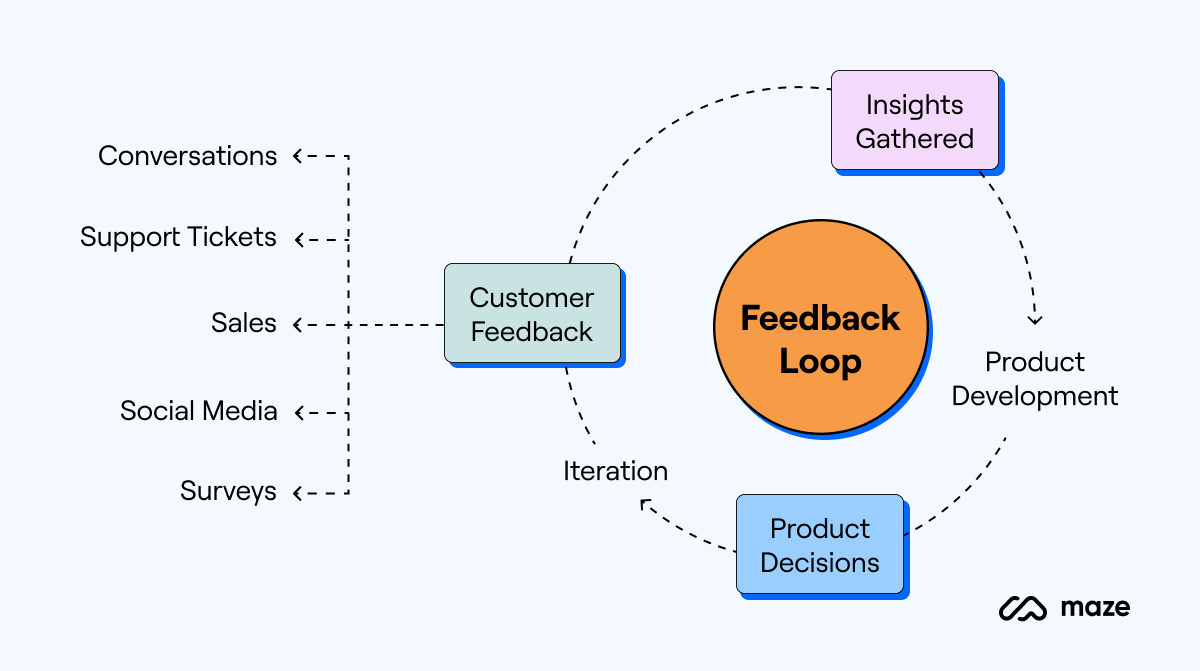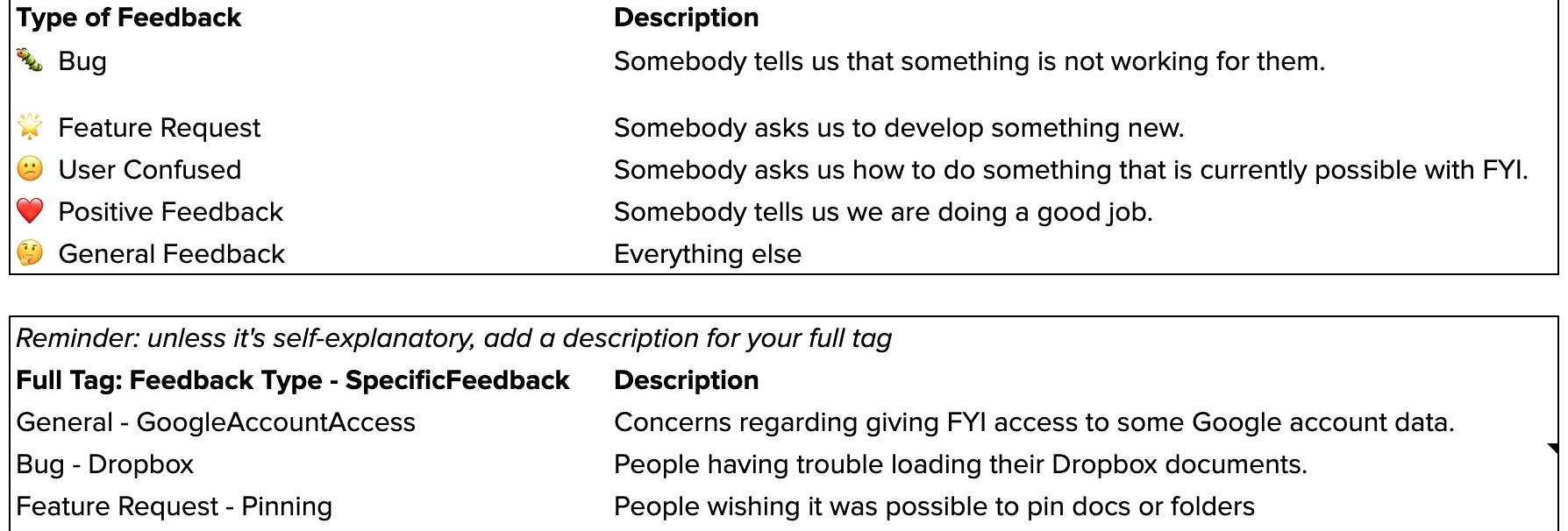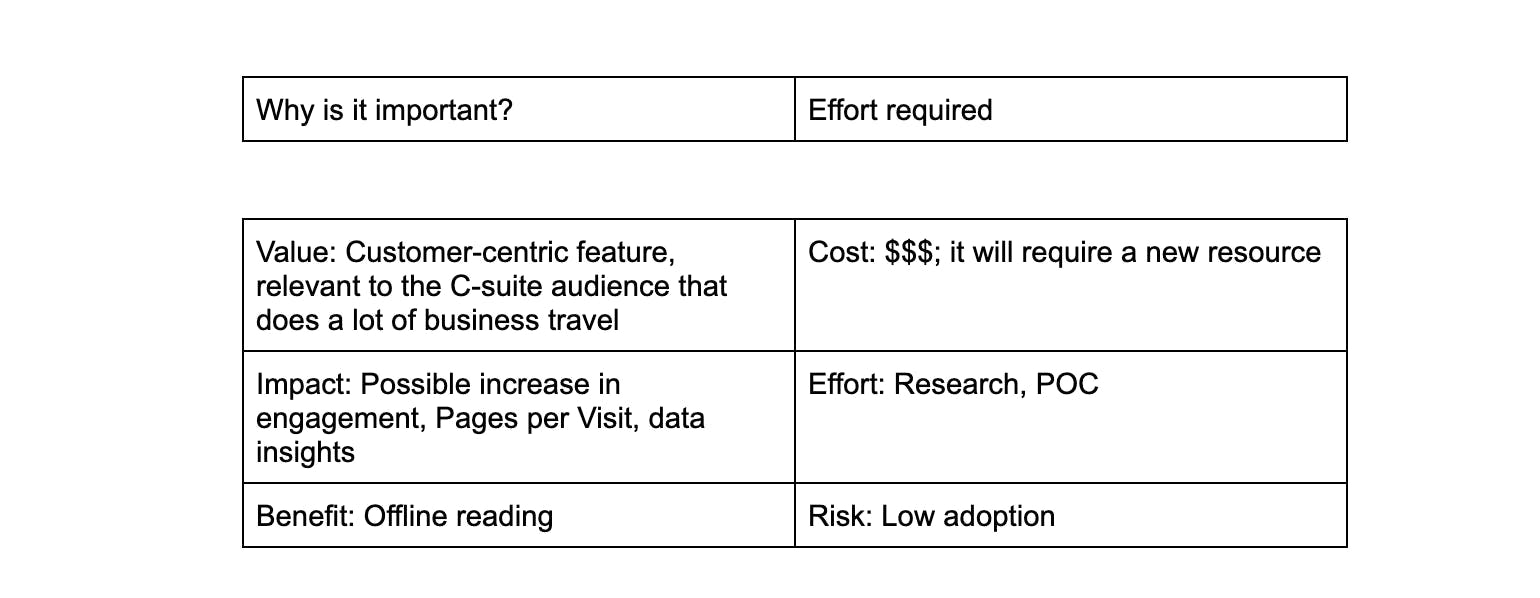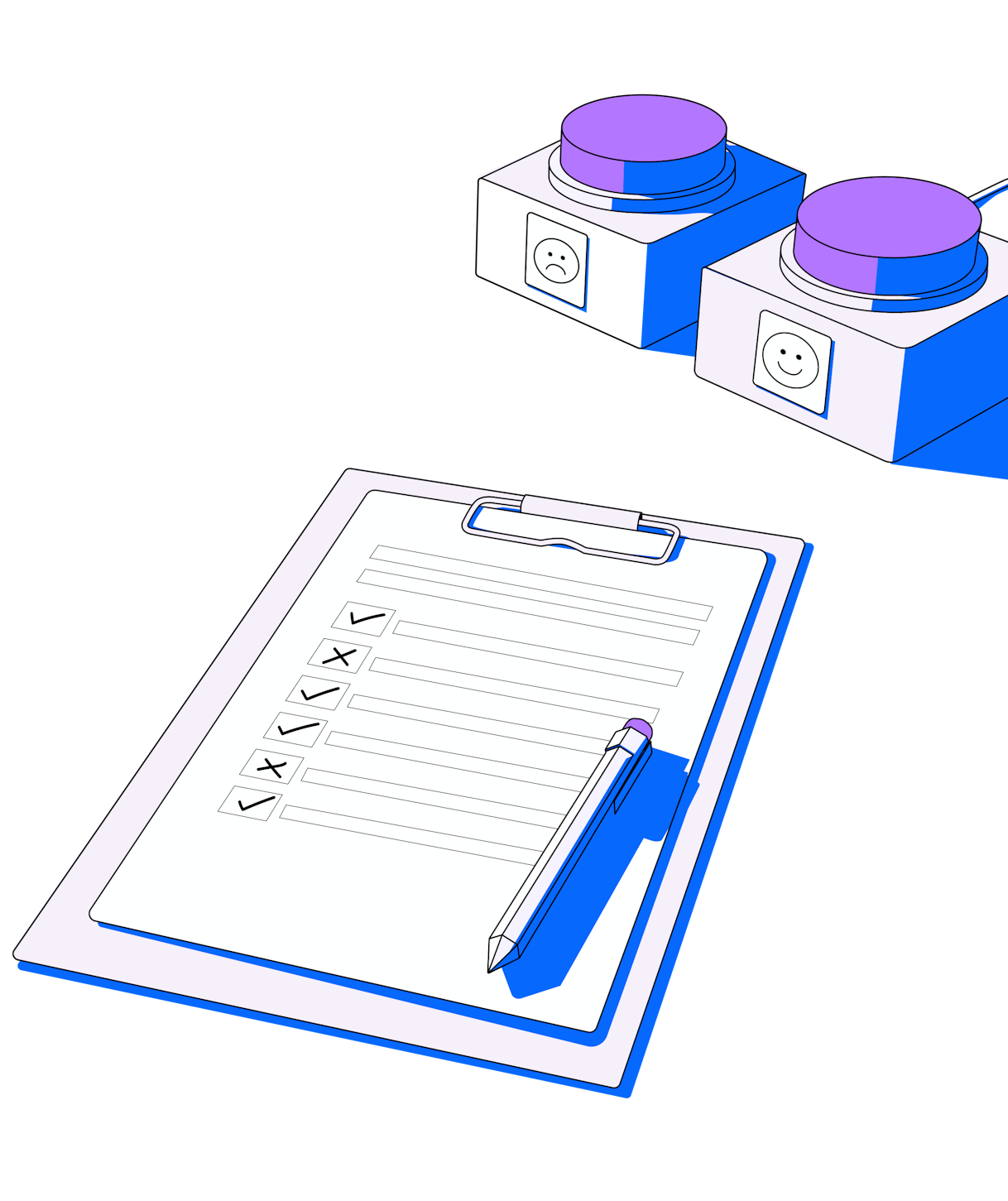Conversations with your customers and feedback are crucial elements for the success of your product. Yet, research shows that 42% of companies don't survey their customers or collect feedback.
Great products aren't built in a vacuum–you need a continuous process of getting feedback from users to guide your product roadmap, tweak messaging, and keep the pulse on satisfaction levels.
To find out how to build a continuous feedback loop to feed your product and marketing strategy, we spoke to Anna Shutko, Product Marketing Manager at Supermetrics, Marco Piras, Growth Product Manager at FYI, Divyam Kaushik, Digital Product and Program Manager at Deloitte, and Karolis Vanagas, Product Manager at Zest.
Read on for key takeaways on how product and marketing teams can collect product feedback and get actionable user insights.
What is product feedback?
Product feedback is any information shared by your users about their experience and satisfaction with the product. You can collect product feedback through a variety of research methods like user interviews, customer surveys, evaluating customer support tickets, and more.
Product feedback ensures that we aren’t going to build products without having an idea of the potential impact of what we build for people. It ultimately helps us to spend less time building things that people don’t need.
Marco Piras
Product Manager at FYI
Share
At Maze, collecting feedback early in the product development process helps inform our decisions and iterate fast. Having direct access to customers shapes the product roadmap and allows the product team to iterate rapidly on feature ideas, designs, messaging, and more.
Our users are with us from an early stage of the design process, and so they feel involved in the development of the product.
Jolanta Gil
Lead UX Designer at Maze
Share
Divyam from Deloitte echoes this: “We ensure that customers are involved in product development from the very start. This makes them involved and excited about the product.”
Product feedback: types and methods
There are a variety of product feedback methods you can use to set up a product feedback loop and allow your customers to get in touch with you.
Generally, product feedback can be either solicited or unsolicited:
- Solicited feedback is when you ask users to provide it. This could be sending out a survey to your customer base or running interview sessions with users.
- Unsolicited feedback is any type of feedback that users share without being asked to. For example, they might leave a review online or share a comment on social media.
Unsolicited feedback usually comes up when users encounter issues within your product, have requests for new features, or need a hand getting something done.
On the other hand, with solicited feedback, you need to provide users with context and ask the right research questions. Depending on what your team needs feedback on, here’s a rundown of the methods you can use to gather solicited product feedback:
- Surveys
- Customer interviews
- Product analytics
- Focus groups
- Customer support conversations
- Sales and customer success calls
Let’s look at the first three in more detail.
1. Surveys
Surveys are an effective research tool that provides you with specific product feedback for various use cases: analyzing the performance of new launches, validating ideas and new concepts before starting the building process, testing product messaging, and more.
Most product surveys use a combination of open-ended and closed-ended questions. There are several best practices to keep in mind when creating and sending out surveys, namely:
- Avoid leading questions, like “How much do you enjoy using this product?” Instead, ask your users to provide details about their experience without leading them towards a positive or negative answer.
- Keep ‘em short: be mindful of respondents’ time and willingness to provide you with feedback. Include no more than five to seven questions in a survey to keep it relatively short and still get actionable feedback.
- Use a combination of open- and closed-ended questions. Too many open-ended questions will result in long surveys as participants will have to type out replies for each question. On the other hand, a survey made up of only closed-ended questions like Yes/No questions will only provide you with quantitative data that won’t reveal the reasons why participants gave you those answers. A combination of both types of questions creates an effective survey.
Get early product feedback from real users. Here are some of our pre-built feedback surveys ready for you to copy, customize, and share with your users:
- Get fast product feedback: Gather both qualitative and quantitative user insights to validate product decisions
- Get first impressions on new features: Learn how satisfied users are with your new build, understand their experience so far, and see what may need to change in the future
- Get live website feedback: Collect user insights on live web pages to improve engagement and conversions
- Get fast NPS feedback: Gather insights to understand user satisfaction and brand perception
- Beta testing feedback: Gather some real-time feedback and reveal user challenges during beta tests
2. Customer interviews
Customer interviews are a versatile research method to get insightful feedback throughout the product development process. From conducting initial design research to getting post-launch feedback–speaking to users can always yield new insights.
At Maze, we get in touch with our Customer Advisory Board (CAB) members every time we need to validate a new concept, test new product features, and get strategic feedback.
Similarly, for product marketers, interviews are a helpful way to get input on messaging for new products or features.
It's a marketer's job to make sure the product narrative is communicated clearly, and we take a lot of feedback from the customers before the product is even developed to make sure we’re creating something the users actually need.
Anna Shutko
Product Marketing Manager at Supermetrics
Share
Whatever the goal, the key to conducting great customer interviews is to ask non-leading questions and let the conversation flow naturally.
3. Product analytics
Product analytics is an excellent source of insights about how the product performs and how it can be improved. Useful for product managers and marketers alike, product analytics can help you understand what users are doing as compared to what they are saying, which might not always be the same.
If you’ve done qualitative testing before a release, product analytics can help you validate your initial assumptions and close the loop on new feature development.
Additionally, product analytics is a good source for identifying severe issues within the product. For example, measuring analytics like retention lets you keep track of it over time or compare the rate with industry standards. And when any anomalies happen, the data is a starting point for doing more research into understanding what the issue is. “Those who deviate from the average think differently, and it helps us create new segments to reduce churn, increase retention, or achieve other goals,” says Karolis.
The importance of creating a product feedback loop
You can use many methods to collect product feedback, from the three ones we looked at above to additional ones like social media monitoring, customer support tickets, sales calls, customer success calls, and more. The more important thing is to create a process through which feedback reaches your organization consistently and is acted upon, thus soliciting more user feedback. This is also known as a product feedback loop.
A feedback loop is an iterative process whereby insights gathered from customer feedback are implemented into the product development process and used to inform product decisions on a consistent basis. The process repeats indefinitely as new feedback influences new product strategies, and changes prompt additional feedback from customers.
This constant feed of customer feedback will help you keep the pulse on customer satisfaction and establishes an open channel between you and your customers.

The product feedback loop
How to collect great feedback
Not all feedback is equal or, for that matter—useful. Just like conducting any other research method, collecting great feedback requires understanding and following key best practices. Here’s what you should know.
Establish clear goals
Before you even begin collecting feedback, the first step is to define your goals and establish clear ways you’ll measure them.
A good starting point is looking at the KPIs you’re responsible for. For product teams, that might mean activation or user retention. For product marketers, that may also be qualified signups and usage metrics. “Your KPIs help you form questions that you need to ask your customers,” explains Divyam Kaushik, Digital Product and Program Manager at Deloitte.
What’s more, the goals you establish will also help you choose the right method to gather feedback. For instance, customer interviews are great for getting qualitative feedback when doing initial discovery research. On the other hand, prototype testing is best for validating designs with users before development. Establishing your goal is the first step towards getting the feedback you need to make informed decisions.
Ask the right questions
Next, asking the right research questions is a key step to getting effective, reliable feedback. After you establish your goal, the next step is to craft out the survey you need to send users or prepare your research plan for customer interviews.
There are some important guidelines to keep in mind when crafting research questions. Some of these are:
- Avoid leading the participant towards an answer
- Avoid closed-ended questions, especially in a customer interview
- Reference specific moments, like using a feature or a new product
*Learn more about asking the right research questions. *
Let the conversation unfold organically
While following a list of pre-written questions is a good method to prompt the participant to share feedback; during interviews, pay close attention to any strong feelings, and listen to users’ stories and experiences. Marco from FYI shares more on this:
Listen to people’s stories and pay extra attention when they mention challenges they have with the product. Ask very broad questions to understand how they’re using the product or a competitor, and let the conversation unfold organically.
Marco Piras
Growth Product Manager at FYI
Share
Be open and approachable
It’s easier to collect feedback if you make it easy for customers to get in touch with you. Whether that’s by providing a live chat on your website or being approachable on social media, give customers different methods to share their feedback.
Being open to unsolicited feedback also signals to customers that you value their input, making them more willing to share more in-depth feedback.
“At Zest, the channels for feedback are open and any user who wants to talk to us can reach us in real-time easily. Zest also goes a step further and makes bonds with the user base. The approach to feedback or any customer interaction is to be as personal as possible. The feedback, therefore, is much more in-depth, thoughtful, and relevant," adds Karolis.
Turning product feedback into actionable ideas
Establishing a process that turns feedback into actionable insights is a key part of making product feedback effective for you and your team. Here’s a step-by-step guide on how to do this:
Step 1: Synthesize the feedback into categories
First, start by analyzing the feedback collected and sorting it into categories. Examples of categories can be bugs, feature requests, or general improvements. “Feedback is always synthesized so we get the bigger picture. If we have indications to improve functionality, build or fix something, we use that feedback to persuade colleagues to investigate further and help decide if it’s worth taking action,” mentions Karolis.
By grouping similar types of feedback together, you can easily spot prominent patterns. Many feedback collection tools like Canny or Nolt automatically measure and categorize user feedback for you and offer metrics such as upvotes to know which ideas are most popular.
“We categorize and analyze the data we collected to find patterns. We’re looking for elements within those stories that people have in common. We use those insights to come up with new assumptions to test in the product,” says Marco Piras, Growth Product Manager at FYI.
Categorizing the feedback into different types is particularly helpful if you’re dealing with customer support tickets or open-ended replies in a survey field, such as “Do you have any other feedback for us?”.
“Segmentation helps to explain connections and get the full context around a piece of feedback. Use the insights from this process to inform your intuition, and decide what changes to test in the product next,” explains Marco Piras, Growth Product Manager at FYI. Here’s how they categorize the different types of feedback the FYI team collects:

How the team at FYI categorize product feedback
“I paste every piece of feedback in a Google Sheet and then tag it as “Type of Feedback" and "Specific Feedback". The combination of those two is the full tag and is what I look at when I check what's the most frequent feedback we're getting,” says Marco.

How the team at FYI tags product feedback
Step 2: Analyze the context
Once you start categorizing feedback, clear patterns will start to emerge. This process will help you see which ideas are most requested by users and prioritize them in order of importance, relevancy, and business sense.
For every idea, think about the context surrounding it: things like who provided the feedback, their use case, or similarities to the existing product, etc.
Ideally, you should have background info about the participants and have made enough notes to jot down the relevancy of any feedback and why it would be important (or not) to act on it. If you decide to implement the feedback, this context will help you frame the reason you’re doing it and establish the problem statement. “We have rough insights of who and what we don’t want to see in feedback, and from there, it’s about evaluating if there’s any critical mass in the feedback, based on where it comes from, what the pain points are, and the context behind it,” says Karolis.
For example, let’s say your tool is a to-do app that allows people to create simple to-do lists. Recently, you’ve been getting feedback from your customers who complain about having to switch tools to create a task with a partner who uses Google Calendar.
At the same time, other users want the ability to see their full schedule for that day in the app, including events signed up for with their Google email. While the two requests come from different pain points, they may both be solved by an integration with Google Calendar. The context surrounding the complaint is important in defining a solution.
Analyzing the context behind a piece of feedback is necessary to prioritize ideas, which is the next stage of the process.
Step 3: Prioritize ideas
While you might get excited about new product ideas coming from customer feedback, you won’t have the time nor resources to develop them all. Prioritization is key—identifying which ideas are most important to your users and make business sense for your organization is a key step to acting on feedback. “We estimate the complexity when it comes to the idea implementation and then calculate the return on time and resources invested," says Anna Shutko, Product Marketing Manager at Supermetrics.
There are various prioritization techniques you can use to determine what to work on. Divyam Kaushik, Digital Product and Program Manager at Deloitte, recommends a few questions to help you prioritize ideas:
- “Does it align with your strategy?”
- “How will it impact the revenue or profits?”
- “Will it attract new customers or increase the loyalty of existing ones?”
- “Do you have any planned enhancement that this can be clubbed with?”
At Deloitte, the team uses the Value vs. Effort framework to determine which feature idea to move forward with. “This approach is based on a lot of estimates, but it helps you prioritize and provide incremental product value,” says Divyam.
“For one of the products that I was managing, we received customer feedback asking for an addition of an offline reading capability of the content so that executives can read it while traveling. We decided not to go forward with it after running it through the Value vs. Effort framework, ” says Divyam. Here’s a look at that analysis in detail:

Running a feature request through the Value vs. Effort framework - Example from Deloitte
Similarly, the FYI team adopted the Worth-What-Why framework to identify which ideas are worth working on. The framework is based on three questions:
- “Is it worth it? Is there some trend suggesting customer demand is growing?”
- “What is it? What is the problem that people are facing and wish to solve?”
- “Why? What motivates people to take action? What are they bothered by? What do they love?
Step 4: Test and validate the idea
Once you’ve decided on an idea to work on, it’s time to start researching possible solutions and validate them with customers. Testing the idea at this stage is key as there are different ways to solve an issue, so you need to find the best solution in terms of user needs, design and development resources, or internal criteria.
One way to rapidly test your product ideas is using a remote testing platform like Maze. Learn more about idea validation with Maze.
3 key benefits of product feedback
Although there are many benefits to actively collecting and analyzing product feedback, they can be summed up into three key benefits:
- Improving customer experience and satisfaction
- Prioritizing the product roadmap and validating new ideas
- Building a successful product
Let’s look at them in more detail.
1. Improving customer experience and satisfaction
In a world with so many products, customer experience is everything. Product feedback helps us create that. There’s a reason why people buy Apple year after year.
Divyam Kaushik
Digital Product and Program Manager at Deloitte
Share
Offering a great customer experience to users is no longer a unique advantage—it’s expected. After a product launch, collecting product feedback helps you identify any issues, gather information on new features to add or improve, and find ways to help users get the most out of their experience.
Before building a product, you make assumptions about the value that people will get out of it. After you ship, you want to know if you were right or wrong and understand why.
Marco Piras
Growth Product Manager at FYI
Share
Support tickets are usually good at revealing repeating issues that need to be addressed as soon as possible. If an issue comes up multiple times, then you know it’s bothering a large part of your customer base. Additionally, surveys like the Net Promoter Score (NPS) or customer satisfaction score (CSAT) are great sources of product feedback and can help you understand how to improve your customers’ experience.
2. Prioritizing the product roadmap and validating ideas
Conducting research helps product managers prioritize the product roadmap and make informed decisions based on actual user needs. Here’s Divyam from Deloitte on this:
Product managers can keep guessing what customers want, but customer feedback gives us data that we can rely on and form future sprints. This is the only way to adjust our products to perfectly fit customer needs.
Divyam Kaushik
Digital Product and Program Manager at Deloitte
Share
You can collect feedback on feature ideas and quantify the data to know which are most requested. For example, at Maze, all feature requests are tracked internally by our support team, which then lets the product team assess the popularity of the feature and decide if they want to include it in the next product build cycle.
3. Building a successful product
Nowadays, the best products are built based on continuous interaction with and monitoring of the user experience of the people who use your product day in and day out—your customers. The rise of customer expectations means businesses must collect and identify customer needs constantly to build products that solve real, existing problems.
Every product solves a customer problem and a business objective. If you can democratize the process of product development, it helps you create profitable products.
Divyam Kaushik
Digital Product and Program Manager at Deloitte
Share
Product feedback is a great mechanism through which to capture insights from users to incorporate into your decision-making process. Whether through solicited or unsolicited feedback (more on this later), listening to what your users are telling you will ensure you can deliver value consistently.
Product feedback gets you in the right direction, by understanding in which situations and how the user is using the product, and in some cases that might be different from what the team imagines.
Anna Shutko
Product Marketing Manager at Supermetrics
Share
Most product teams today have access to online platforms through which to engage with users. Surveys, feedback forms, social monitoring, live chat—you name it. In 2021, making the decision not to listen to what your users are telling you is a sure way to lose out fast.
Final words
Product feedback is a great source of insight into customer behavior and pain points and helps you make informed decisions throughout the product development process.
Everyone working in product and marketing today will benefit from talking to customers and listening to what they have to say. As products mature and as customers' needs change, these conversations shouldn't be a one-off occurrence, but rather a key part of building great products.
This guide to product feedback aimed to give you the impetus and know-how to start talking to customers. Ready to start the conversation?
Frequently asked questions about product feedback
Why is product feedback important?
Why is product feedback important?
There are many reasons product feedback is so important, but broadly speaking there are three main benefits:
- Improving customer experience and satisfaction
- Prioritizing the product roadmap and validating new ideas
- Building a successful product
How do I collect online feedback?
How do I collect online feedback?
Product feedback can be gathered through a variety of research methods like user interviews, customer surveys, evaluating customer support tickets, and more.
What are examples of customer feedback?
What are examples of customer feedback?
Examples of customer feedback include direct verbal feedback during meetings with customers, social media messages or feedback, customer help tickets, newsletter surveys or direct user interviews and research.





